This is the first in a series of articles looking at the practicalities of producing ethical, cruelty-free milk by allowing dairy cows to keep their calves. In this post we cover why conventional dairy cows don’t keep their calves and why humanely-produced milk using cow-calf dairying is rare and costs much more to produce.
Over to Christine:
When customers come to collect their milk from our farm shop I often take them down to the field to see the cows and calves. When you see them together, it becomes obvious what cow-calf dairying means.
However, it may not be obvious why calves in the conventional dairy industry are routinely removed from their dam. Why can’t dairy cows, who are selectively bred to produce more milk than their calves need, simply keep their calves and give extra for us humans to drink?
Why conventional dairy cows don’t keep their calves
The answer is simple: most consumers are not willing to pay the true cost of this kind of high-welfare milk production. Many of us have been conditioned into a false perception of milk as a low value product, sold at ‘loss-leader’ prices by supermarkets, often cheaper than bottled water.
There are five main reasons why a litre of milk is considerably more expensive to produce from a cow-calf dairy compared to a conventional dairy and why, therefore, conventional dairy cows don’t keep their calves
- Time: Labour costs money and the increased labour associated with cow-calf dairying stems from the significant extra time required to develop special relationships with the cows whilst training them to overcome their innate desire to only give milk to their calves. Additional labour is also needed to separate the cows and calves in preparation for milking and/or to manage the practicalities of having cows and calves around or in the milking parlour at milking time.
- Facilities: Additional infrastructure is needed both when cows are out grazing and also during the winter. Most dairy cows are housed for around 5 months over winter. Standard practice on conventional dairy farms is to use cubicles as these are cheap to manage. But cubicles are not practical or hygienic for calves, so cows with calves need to be loose housed on straw in large airy barns. This adds significant cost to the operation, not just in initial infrastructure but in ongoing costs of buying straw, which is becoming increasingly more expensive, and also in the labour to bed the cows down each day.
- Lower Yields: Milk yields in a cow-calf system are significantly lower than in a conventional system for several reasons. First, cow-calf dairy cows are usually milked only once a day because it becomes impractical to milk more than this with calves suckling. Second, you are constantly playing second fiddle to the cow’s innate desire to give milk only to her calf, so even when she does give her milk in the parlour, she rarely gives it all until after her calf is weaned. Third, calves can drink significant quantities of milk as they grow, far more than they actually need or indeed is good for them. So even if you can manage the delicate art of creating a bond with your cow so that she wants to give her milk to you as well as to her calf, you still have to figure out how to stop the calf drinking it all! And fourth, cow-calf systems routinely keep the calves with the cows for a more natural length of time, which is often twice or more as long as conventionally raised calves are fed milk.
- Learning the Art: Cow-calf dairying is a perplexing and specialist art with innumerable challenges. It can take years to perfect, and even the most experienced can hit unforeseen stumbling blocks. It requires commitment, tenacity and patience. There are few resources for farmers who seek knowledge and mistakes can be very costly in lost productivity, especially when multiplied up by many cows. So without a known market of customers willing to pay the true value, the idea of stepping off the conventional conveyor belt into an abyss of unknowns to try and produce milk from cows who also raise their own calves, is a leap that is understandably beyond comprehension for most dairy farmers.
- Best Practice: The type of dairy farmer who might transition to a cow-calf system would be one already inclined to best practice in the industry. They would probably feed less grain, use fewer inputs, be more focused on sustainability and animal welfare and more likely to be organic than is the norm in a conventional system. So they are already producing a better product that will be more expensive than average to produce.
Cow-calf dairying must have been practiced since bovines were first domesticated over 10,000 years ago. It would be a fascinating project to look back over the millennia of civilisations to see how and where calves were first separated from their dams in order to increase the amount of milk available for human consumption.
Regardless of how cow-calf dairying has been practiced in the past, the farmers would have experienced many of the challenges we experience today. My aim in this series of blogs is to unpack some of these challenges and offer suggestions for those wishing to try this more ethical way of milk production.
Today’s big dairy business
The dairy industry today is big business. There are around 1.9 million dairy cows in the UK. Both large conglomerate processors wanting cheap raw materials for processed food and also supermarket demand for milk to fill a ‘loss-leader’ slot, have de-valued milk into a highly processed global commodity. This has driven prices down and many small dairy farmers out of business. Those that remain have had to get bigger and more efficient in order to survive.
As explained, this type of efficiency has no place for the additional costs and lower returns of allowing the calves to suckle on their dams. So in both conventional and organic systems, calves are routinely removed from their mothers within the first 24-48 hours. They are bottle-fed either with fresh cows milk or with a milk-replacer made with skimmed milk or whey powder: 2 litres every 12 hours is standard practice. In order to meet minimum welfare standards, the calves must be given milk until 8 weeks of age in conventional systems, and until 12 weeks of age in organic systems. Even 12 weeks, however, is significantly shorter than the period for which a young bovine might naturally suckle on its dam.
Cow-calf dairying
Nonetheless, even though cow-calf dairying plays no part in the mainstream dairy industry, there is a handful of pioneers now producing more ethical milk and, in one form or another, raising calves on their mothers. It’s a start, and hopefully a trend, that will lead to many more cow-calf dairies popping up around the country in response to demand from a small but growing number of compassionate consumers.
Running a cow-calf dairy really is an art. In these blogs I will cover the system we use at Smiling Tree Farm and the reasons why. But I would stress that it’s just a guide, not hard and fast rules. It’s what I call my ‘Pirate’s Code’ for cow-calf dairying (with apologies to those who haven’t seen the movie Pirates of the Caribbean)!
In order to get to grips with this rare art and to better appreciate some of the challenges and potential pitfalls, there are some key physiological and psychological factors that it’s important to understand. For cows: how milk is made and, particularly, the process of release (‘let down’), which I will cover in my next post. And for heifer calves: the growth and development of both their rumen and their udder.

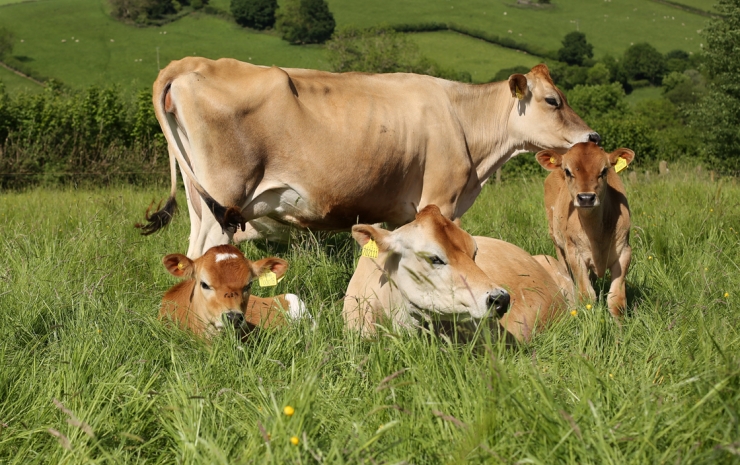
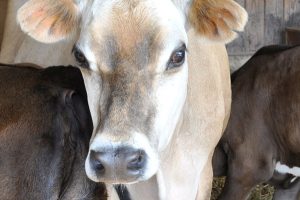
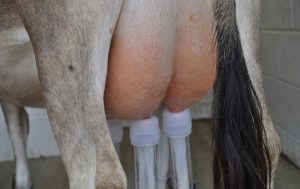
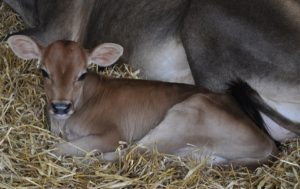
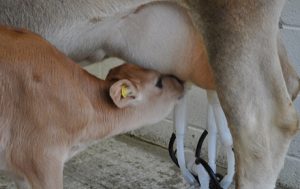
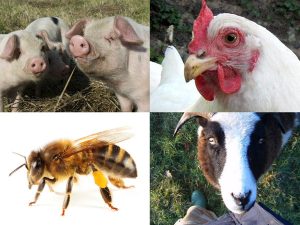
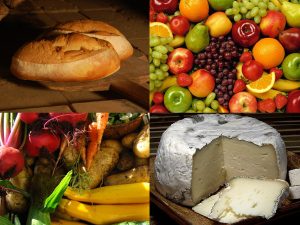
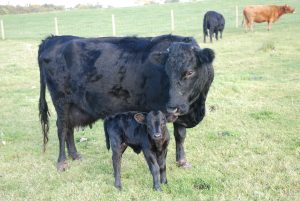
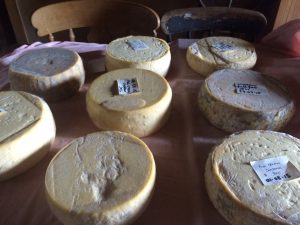
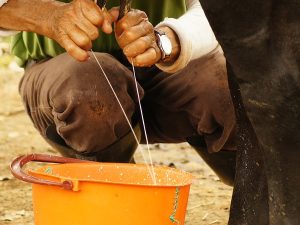
15 Comments
My partner and I stayed in a cottage next to a dairy farm last year, and the cows were wailing – it almost sounded like screams. We asked the farmer what was happening and he said that it was ‘nothing’ – just that the calves had been removed from the mothers. Both calves and mothers were screaming for each other – I may be anthropomorphising, but I don’t think so. Taking babies away from mothers is pretty primal stuff, and it’s not seeing things from a human perspective to assume that they were suffering, I don’t think.
We were also sent a link to a video about the conventional dairy industry, and how cows are constantly impregnated, their babies removed and then (over-) milked until they collapse with exhaustion – and that was it. We’ve switched to oat milk and given up dairy, until and unless we can find a cruelty-free source of cheese or butter. If we lived near you, we’d get milk from you (although oat milk is quite nice – not the sacrifice I thought it might be).
Hi Dave
My family were in the same situation until we discovered the Calf at Foot Dairy……real unpasteurised milk, from ethically treated cows allowed to keep their calves until natural weaning. Mail order service. Check them out…..
Yes, I know them – in Suffolk. Not sure about mail order though. I’d prefer something more local. As we’re in London at the moment, that’s a bit difficult – not many cows around here. However, a group of us have started talking about selling our places in London and setting up a housing co-op in a small town somewhere. We can then check out local farms / CSA schemes / micro-dairies etc. Don’t know if we’re going to find a local cow-calf dairy, but hopefully micro-dairies, especially those that leave calves with cows, will spread.
Currently living in the Highlands of Scotland, and have been watching the cows in nearby fields all year. They are very caring creatures and lovely to watch as they lick and nose their young even when the calves are as big as their mothers.
Two days ago the bull calves were removed for slaughter. The cows (their mothers) are in barns now and have been lowing continuously night and day since bull calves were taken away, I assume calling for them in the hope that they’ll come back.
This is nonsense.
Unless the farmers are willing to exponentially increase their stock them the calves must be killed, (read murdered).
Is it ethical to enclose an animal which would naturally roam hundreds of miles?
Is it ethical to prey on its offspring?
Is it ethical to use modern breeds of cow?
Is it ethical to perpetuate the use of dairy? An addictive substance meant for babies.
Look up casomorphins.
There is no such thing as “ethical milk”, but the milk from a mother to it’s child.
Take a look at it without being misled and see the perversion for what it is.
Humans are equal to all other animals, and we have no right to prey upon them.
This is far better than the standard, by it is myopic.
Just drink plant based milk and cut out the suffering. Ethical milk is a pie in the sky.
The calves will still be taken from their mothers in time. The males killed.
The cows will still suffer from the problems inherent in modern milking cows, such as mastitis.
Milk is for babies and cows milk is for calves.
This time of year the cows wail at the Los of their children.
I find it hard to believe they expect them to come back, since they will have experienced this extreme trauma annually.
John, this is a deep, philosophical discussion that needs to be had. But no-one is ‘right’ or ‘wrong’ about this – ethics is something we need to work out collectively through careful discussion. But you seem to be taking a position that you don’t think can be challenged – that you’re right and Christine is completely wrong. What you’re stating is your opinion, not fact or some clear moral correctness. In time, your position may turn out to be the norm – people may look back on the keeping of animals with the same abhorrence that we look at slavery or witch-burning now. But at the moment, the vast majority of the world eats meat and dairy products, and so we would like animals to be kept as sustainably and humanely as possible.
You mention ‘murder’, which is, as you know, a very emotive word. But if that’s the case, then nature itself is based on mass murder. Your position may be that only humans have the mental faculties to be capable of ‘murder’, but that’s not really any consolation to the animals that are killed. Right now, millions of animals all over the world are being torn apart by other animals. I once watched a sparrow-hawk take a pigeon, and proceed to eat it alive, tearing chunks of flesh out of it for half an hour, before it stopped struggling. Nature is very, very cruel, and it might be argued that protecting domestic animals from predators and disease, making sure that they always have enough food, and ending their lives quickly is relatively compassionate. Even if humans stop keeping or killing animals altogether (and that would mean the end for some cultures, like the Inuit or the Maasai, for example), would you then be happy, knowing that we can never live on a planet free from extreme animal suffering, unless we destroy nature, and therefore ourselves?
Personally, I’ve taken a good look at the mainstream dairy industry, and decided to use oat milk instead. The taste is fine, and oats are grown in this country (unlike soy). But if people are going to continue to drink milk, then I’d prefer it if the dairy industry followed Christine’s lead, rather than taking calves from their mothers.
We’ve blogged before about whether keeping animals is ethical, and your posts have persuaded me to do it again soon.
I was diagnosed as being lactose intolerant in my early twenties, so have not consumed milk for over twenty years. Cutting it out was like breaking an addiction, but I can’t stand the thought of tasting it now. This is notwithstanding the ethics of the dairy industry, but the taste and texture of it. Long ago I read that lactose intolerance was ancestral, because drinking cow’s milk is unnatural. It made sense to me then and it does now.
Stopping eating meat was something that I did by choice more recently. There were many reasons, but mainly my abhorrence of how the corporate meat and dairy industries operate. Like many such life-choice decisions, I wanted to live independently, by my own ethics and not support what I felt was “wrong”, which meant not behaving like that other farm animal: the sheep. I only regret that I didn’t break from this social norm much earlier.
I would be interested to read your blogged thoughts on John’s questions in post number 7 Dave.
For the 1.9 million cattle in the UK dairy industry and the greater number of other creatures who are ill treated, with the lucky ones being killed while young, “mass murder” seems far more appropriate to me than the innate actions of a sparrowhawk who knows no better. I’d describe their treatment as being more akin to child abuse, as these animals are vulnerable.
Smiling Tree farms sounds idyllic, but it seems an awful lot of trouble to go to for a product that humans don’t need. The sparrowhawk is a carnivore, humans are not. Also, what happens to the bull calves at Smiling Tree Farm? At what age are they sent to the abattoir?
Hi Andrew. If enough people can be persuaded, maybe the human species will be vegan one day. But that day is not now. We’ve eaten meat throughout our entire history, and consumed the milk of other animals for many thousands of years. Maybe we always will, I don’t know. We’re an organisation that focuses on the human impact on the earth’s ecology. We’re happy to host debates about whether humans should consume meat or dairy, but there isn’t a definitive answer those questions – just opinions. We regularly stay at an organic farm in mid-Wales where they make cheeses from a few Jersey cows that graze happily in their fields. They don’t have young ones every year, and males live for a few years and are sold for beef. There’s plenty for the young ones, with a surplus for the cheese. I don’t feel in a position to say that that is wrong. We obviously oppose large-scale factory farming.
We have veganism and vegetarianism as topics, as well as keeping animals. Here’s an article about why we do that – https://www.lowimpact.org/why-does-our-list-of-topics-include-vegetarianism-veganism-and-keeping-animals/. And here’s another one about whether it’s ethical to eat meat at all – https://www.lowimpact.org/is-it-ethical-to-eat-meat
Also, just between you and me (and anyone else reading this), I believe that societal collapse is inevitable, after which, the topics that we promote here will be invaluable if we are to survive (although I don’t think that survival is guaranteed). Humans may not then be in a position to refuse to use animal products.
My point about the sparrow-hawk was not to compare its behaviour to human behaviour, it was just to point out that no matter what humans do, many millions of animals will still experience extreme suffering every day. If humans decide to stop consuming meat and animal products, it will ultimately, I believe, be for our own (possibly spiritual) development, rather than to stop animal suffering – which is impossible.
I know Dave, thanks for the comment.
Of course, you are right and we agree on many things, one of which no doubt is that mass-cull, factory-style, animals as throwaway commodities, etc. supermarket milk and meat is wrong in many ways (we haven’t even mentioned the other negative – greenhouse gas emissions, nor some of the positives – keeping a few cattle on a small holding for turning the grass into manure).
As an aside, I started my working life as a 15 year old butcher and used to see the broken bones of the pigs and lambs when they were brought in, with bruises around the fractures to show that they had been kicked/beaten before slaughter. As Ghandi said: “a nation is judged on how it treats its animals”, and the way Britain is today that is a pretty good appraisal that we are in a mess, if one were needed.
I try to be positive, and I think that if civilisation is to get better, then we have to stop animal and dairy farming, completely. It might be nice to see the cows at Smiling Tree farm, and it might make people think a bit. Maybe then, like that starfish thrower story, it is about the importance of individual action.
PS, I’d sooner see cattle roaming wild through forests in their natural habitat.
Yes, a few animals on a smallholding, turning grass into manure – that’s the only kind of livestock farming we’ll ever promote. I just don’t feel in a position to say that it’s wrong. If animals are kept well and killed quickly, they’ll have better lives than a lot of wild animals, and a lot of humans too.
I looked up the starfish thrower – it’s beautiful.
What I will post here will probably be removed. I used to share milk for years. The drama of holding up for calves and cows that do not want to share. The calves and the difference between modern dairy Jerseys is they all have tiny three finger milking machine teats. This caused me to go to removing and bottle raising multiple heifer calves per cow with the use of a milking machine for my one Jersey cow dairy. When born the calf is removed within an hour or two after birth they do not cry for the calf because they have not bonded. You let the cow lick them off then remove them. This is what they do on dairies. I can raise 3 or 4 heifer calves to sell as yearlings vaccinated, dehorned halter broke heifers. This is worthwhile to me and economic without share calf drama. Plus have milk for the house.
I’m not selling raw milk, don’t believe in it. I’m a nurse, seen too many raw milk patients. You don’t know how customers are going to handle/store raw milk and if someone gets sick you can get sued and loose the farm. If people want raw milk they can raise my heifers for their own raw milk.
People are welcome to drink substances made of vegetation call it milk if of makes them feed better. I myself am a lactcto-ovo vegetarian all my life because it does not harm cows or chickens to produce eggs or milk. When they are old and suffering they are instantly dispatched. This is nature only better.
Thank you for other useful blogs on here. Signed, Nurse Bishop
Convention milk or share milk – we don’t remove posts unless they’re abusive or off-topic, which yours wasn’t.
You say ‘When born the calf is removed within an hour or two after birth they do not cry for the calf because they have not bonded. You let the cow lick them off then remove them. This is what they do on dairies.’
Which dairies? My wife and I stayed on a conventional dairy farm on the Yorkshire Moors. We were kept awake all night by the cows and calves crying – it was gut-wrenching, all night. When we asked the farmer what was happening, he said, ‘oh, it’s nothing – we’re just taking the calves from their mothers’.
We haven’t drunk conventional milk since. Luckily, we live in Stroud, where there’s a micro-dairy that keeps calves with their mothers. The milk is a bit more expensive, but we don’t drive, fly, have a TV, follow fashion etc etc, so we spend our money on good-quality, cruelty-free food instead.
I agree that producing milk and/or eggs can be sustainable and cruelty-free, especially as part of a mixed, organic smallholding. But I’m wondering why you say that ‘this is what they do on dairies’ – i.e. the cows and calves don’t cry. I’ve talked with others who live near conventional dairies, and they all confirm that the cows and calves cry terribly. Which dairies do you mean?